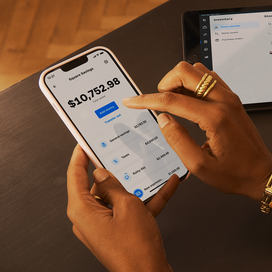Table of contents
At some point or another, you’re going to have to get down with accounting reports. Not the most exciting task, we know, but pretty important. But what kind of accounting reports should you be creating as a small business owner? We asked our friends at Xero to walk you through the most common types. And remember, to make accounting easier in general, be sure to link your Square account to Xero in our App Marketplace.
Accounting reports are powerful documents that provide deep insight into your business’s performance. But unless you have a background in finance, it can be a struggle to make sense of them. Three of the most common are income statements, balance sheets, and cash flow statements.
1. Income statement
An income statement shows how much money your business has made or lost over a period of time. It generally has three parts: total revenue, total expenses, and net income. The hope is that revenue is greater than expenses, resulting in a positive net income.
The purpose of an income statement is to get an overview of everything that influences your bottom line. All the sources of revenue and expenses — from both operating and nonoperating activities — should be listed so stakeholders can get a clear understanding of why the net income figure is what it is.
![Profit and Loss Statement [Downloadable Tool]](https://images-cdn1.welcomesoftware.com/Zz0xOWQ5NzA3Y2JkZWIxMWVkOWQyZmNlMzFjZDhkNzM5MA==?width=272&height=272)
Profit and Loss Statement [Downloadable Tool]
![Profit and Loss Statement [Downloadable Tool]](https://images-cdn1.welcomesoftware.com/Zz0xOWQ5NzA3Y2JkZWIxMWVkOWQyZmNlMzFjZDhkNzM5MA==?width=272&height=272)
2. Balance sheet
A balance sheet provides a snapshot of your business’s financial position at any point in time. This report also has three sections: assets, liabilities, and equity. The value of assets should equal the combined value of liabilities and equity.
Example:
Say you’re starting a landscaping company. You accept a $10,000 loan, which is a liability. The entire amount goes into your bank account, giving you an equal $10,000 in assets.
You then spend $4,000 on a lawn mower. Don’t worry, you still have $10,000 in assets because the lawn mower has a monetary value. You take your new equipment and make $1,500 cutting grass. It’s recorded in your equity column as retained earnings and in your assets column as cash on hand. Let’s do a final review:
- Total assets equal $11,500: $6,000 in loan cash, $4,000 in value of the lawn mower, and $1,500 in cash earned.
- Total liabilities equal $10,000.
- Total equity equals $1,500.
Your assets are the same amount as your liabilities and equity combined. Everything is balanced, just as it should be.
Banks and investors often want to see a balance sheet before they give a loan. It can also be a helpful document for a tax preparer.

Create and Use a Balance Sheet for Your Small Business

3. Cash flow statement
A cash flow statement highlights how much money has moved in and out of your business in a given period of time. It, too, is made up of three sections: cash flow from operations, investing, and financing.
- Cash flow from operations is the money received and spent on running the business. This consists of things like revenue, expenses, and taxes.
- Cash flow from investing is money received and spent on growing the business. This section usually lists the money spent on new equipment or working space. But it can also account for the money earned on selling old equipment.
- Cash flow from finance is any money received in loans or paid out in dividends.
The three sections are added up, resulting in the net cash increase for the given time period. This figure can be added to the cash that was on hand before this time period, reflecting the total cash the business has.
The cash flow statement doesn’t provide a complete financial picture of your business like a balance sheet does. And unlike an income statement, it doesn’t account for revenue that hasn’t yet been received or expenses that haven’t yet been paid. It does highlight your business’s ability to take in and retain cash, which is a good barometer for how efficiently you’re operating.
![Cash Flow Management for Small Business Owners [Template]](https://images-cdn3.welcomesoftware.com/Zz1iMTQyYzhhNmJkZWExMWVkOGNmZjZhMjgzMWJjN2M5YQ==?width=272&height=272)
Cash Flow Management for Small Business Owners [Template]
![Cash Flow Management for Small Business Owners [Template]](https://images-cdn3.welcomesoftware.com/Zz1iMTQyYzhhNmJkZWExMWVkOGNmZjZhMjgzMWJjN2M5YQ==?width=272&height=272)
Accounting reports are great sources of information that can expose problems within your business. You can work with your accountant or bookkeeper to generate these reports, then use the information to identify leaks that are holding your business back from reaching its full potential.
About Xero
Xero is beautiful online accounting software for small businesses. Sign in any time, anywhere, from any device. You can link your Square account to Xero in Square App Marketplace.
![]()











